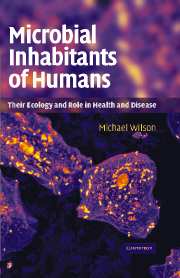Book contents
- Frontmatter
- Contents
- Preface
- Abbreviations used for microbial genera
- 1 An introduction to the human–microbe symbiosis
- 2 The skin and its indigenous microbiota
- 3 The eye and its indigenous microbiota
- 4 The respiratory system and its indigenous microbiota
- 5 The urinary system and its indigenous microbiota
- 6 The reproductive system and its indigenous microbiota
- 7 The gastrointestinal tract and its indigenous microbiota
- 8 The oral cavity and its indigenous microbiota
- 9 Role of the indigenous microbiota in maintaining human health
- 10 Manipulation of the indigenous microbiota
- Index
4 - The respiratory system and its indigenous microbiota
Published online by Cambridge University Press: 06 July 2010
- Frontmatter
- Contents
- Preface
- Abbreviations used for microbial genera
- 1 An introduction to the human–microbe symbiosis
- 2 The skin and its indigenous microbiota
- 3 The eye and its indigenous microbiota
- 4 The respiratory system and its indigenous microbiota
- 5 The urinary system and its indigenous microbiota
- 6 The reproductive system and its indigenous microbiota
- 7 The gastrointestinal tract and its indigenous microbiota
- 8 The oral cavity and its indigenous microbiota
- 9 Role of the indigenous microbiota in maintaining human health
- 10 Manipulation of the indigenous microbiota
- Index
Summary
The respiratory system consists of a series of tubes (the respiratory tract) for conducting air to the respiratory membrane where oxygen and carbon–dioxide exchange occurs with the bloodstream, as well as a ventilatory system consisting of the lungs, diaphragm, and associated muscles. The primary function of the respiratory system is to supply oxygen to, and remove carbon dioxide from, the blood. The blood is transported to all cells of the body by the cardiovascular system. The site of interaction between the two systems is the lung – this organ being responsible for the exchange of gases between them. Other functions of the respiratory system include (1) regulating blood pH, (2) producing sounds, (3) eliminating water and heat, and (4) housing the receptors responsible for the sense of smell. Only the respiratory tract of the system is colonised by microbes and the ventilatory system is not described further.
Anatomy and physiology of the respiratory tract
The respiratory tract, which is also referred to as the “conducting portion” of the respiratory system, delivers air to the lungs (known as the “respiratory portion”), where gas exchange takes place. The conducting portion consists of the nose, pharynx, larynx, trachea, and bronchi, whereas the respiratory portion consists of the bronchioles, alveolar ducts, alveolar sacs, and alveoli (Figure 4.1). The conducting portion, apart from the bronchi, is heavily colonised by microbes, whereas the respiratory portion is generally sterile.
- Type
- Chapter
- Information
- Microbial Inhabitants of HumansTheir Ecology and Role in Health and Disease, pp. 128 - 181Publisher: Cambridge University PressPrint publication year: 2004
- 2
- Cited by



